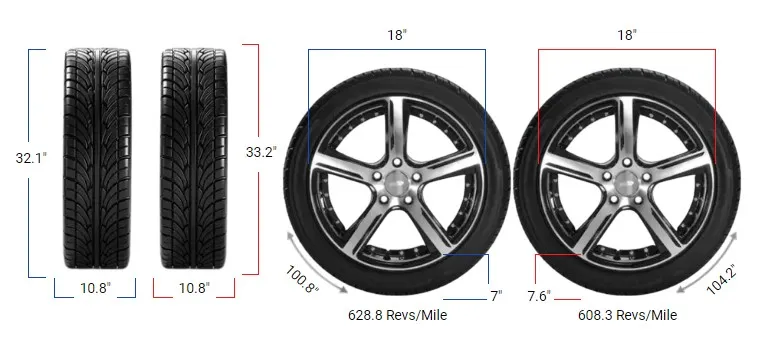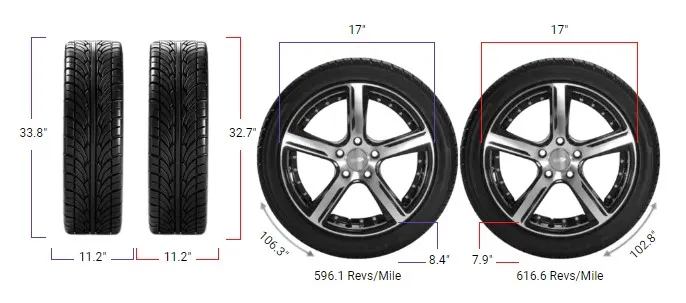Tire Size 215/75r15 vs 215/70r15

Switching from 215/75R15 to 215/70R15 may seem like a small change, but it can impact your driving experience in ways you may not expect. Understanding these differences is key to making an informed decision.
- The shorter sidewall may provide a stiffer ride, especially on bumpy roads.
- Handling on paved roads may improve due to the lower profile of the tire.
- Speedometer readings will be slightly inaccurate, showing a higher speed than actual.
- The change in circumference may lead to a marginal improvement in fuel efficiency.
- There is no change in tire width, so traction remains consistent between both sizes.
- Aesthetic appearance may change, making the vehicle look slightly lower and more compact

Fitment Guide
The difference between 215/75R15 and 215/70R15 is 3.1%, which slightly exceeds the recommended threshold.
While this is marginal, it could lead to clearance issues or slight rubbing, particularly in off-road scenarios or vehicles with tight wheel wells.
If you’re determined to switch, adaptations like adjusting suspension or trimming inner fender components might be necessary to avoid these problems.
On-Road Impact
When driving on paved roads, the switch from 215/75R15 to 215/70R15 will primarily affect ride comfort, handling, and speedometer accuracy.
The difference in diameter leads to a lower ride height, which can improve handling but may slightly reduce your ground clearance.
A shorter sidewall height also makes the tire stiffer, contributing to better cornering but potentially rougher ride comfort.

Off-Road Impact
Off-road driving puts more emphasis on ground clearance and durability, and the switch between these two tire sizes can have more noticeable effects in rugged conditions.
With the 215/70R15, you’ll lose some ground clearance due to its smaller diameter, which may make tackling obstacles like rocks or steep inclines more challenging. However, the tread width remains the same, so traction will not be affected significantly.
Ground Clearance
Switching from 215/75R15 to 215/70R15 reduces your overall ground clearance by about 0.85 inches. While this difference may seem small, it can affect how your vehicle handles uneven terrain, particularly in off-road situations.
On-road, the impact is minimal and may not be noticeable in daily driving, but off-road, where every inch counts, it could make certain obstacles more difficult to overcome.
Gas Mileage
One potential benefit of switching to the slightly smaller 215/70R15 is improved fuel efficiency.
The smaller diameter reduces the revolutions per mile, meaning your engine has to work slightly less to turn the tires, which could lead to marginal improvements in gas mileage.
However, this difference is often so small that most drivers won’t notice a significant change unless they do a lot
 of highway driving.
of highway driving.
Aesthetics Look
A smaller tire like the 215/70R15 may change the overall look of your vehicle, making it appear slightly lower and more compact.
This can be a desirable aesthetic for those looking for a sportier profile, but if you’re after a rugged, off-road look, the larger 215/75R15 might be more appealing. It’s all about personal preference when it comes to the visual impact.
Ride Comfort
The 215/70R15 comes with a shorter sidewall, which can make the ride feel a bit stiffer compared to the 215/75R15.
On paved roads, this translates to better handling in corners but can result in a slightly rougher ride over bumps and potholes.
On the other hand, the taller sidewall on the 215/75R15 offers more cushioning, making it a better option for drivers who prioritize a smoother ride, especially on uneven roads or when carrying heavy loads.
Speedometer Accuracy
Due to the diameter difference, your speedometer will read higher than your actual speed if you switch to 215/70R15. For instance, if your speedometer reads 20 mph, your actual speed will be closer to 19.39 mph.
While this is a minor difference, it’s something to be aware of, especially if you rely on precise speed readings for navigation or fuel efficiency calculations.

Durability & Wear
Both tires have the same width, so wear patterns won’t change drastically. However, the shorter sidewall of the 215/70R15 could lead to more frequent impacts with road hazards, increasing the risk of sidewall damage over time, especially in off-road conditions.
If you frequently drive on rough terrain, the 215/75R15 may provide better durability due to its higher sidewall and better ability to absorb shocks.
215/75r15 vs 215/70r15
| Feature | 215/75R15 | 215/70R15 | Difference |
|---|---|---|---|
| Diameter inches (mm) | 27.7 (703.5) | 26.85 (682) | -0.85 (-21.5) -3.1% |
| Width inches (mm) | 8.46 (215) | 8.46 (215) | 0 (0) 0% |
| Circumference inches (mm) | 87.01 (2210.11) | 84.35 (2142.57) | -2.66 (-67.54) -3.1% |
| Sidewall Height inches (mm) | 6.35 (161.25) | 5.93 (150.5) | -0.42 (-10.75) -6.7% |
| Revolutions per mile (km) | 728.17 (452.47) | 751.13 (466.73) | 22.96 (14.26) 3.2% |
| Speedo Reading | 20 mph (32.19 km/h) | 19.39 mph (31.2 km/h) | -0.61 mph (-0.99 km/h) |
Difference Between 215/75r15 and 215/70r15
The main difference between these two tires is the overall diameter. The 215/75R15 is about 0.85 inches taller than the 215/70R15, impacting ground clearance and speedometer accuracy.
Can I Use 215/70r15 Instead of 215/75r15?
Yes, you can use the 215/70R15 as a replacement for the 215/75R15. However, keep in mind that it is just outside the recommended 3% diameter range for tire interchangeability.
How Much Taller Is a 215/75r15 Tire Than a 215/70r15?
The 215/75R15 tire is approximately 0.85 inches taller than the 215/70R15, which slightly affects aspects like ground clearance and ride height.
Our Observation
Switching from 215/75R15 to 215/70R15 comes with both benefits and shortcomings. On paved roads, the smaller 215/70R15 may provide better handling and possibly a slight improvement in fuel efficiency, but the ride could feel stiffer due to the shorter sidewall.
Ground clearance is reduced by 0.85 inches, which may not be a big deal on roads but could pose a challenge in off-road scenarios where every inch matters.
Additionally, the speedometer will read slightly higher than your actual speed. If your vehicle is primarily used for on-road driving and you prioritize handling, the switch could be beneficial.
However, if you need extra clearance or prefer a smoother ride, sticking with the 215/75R15 might be the better option.



